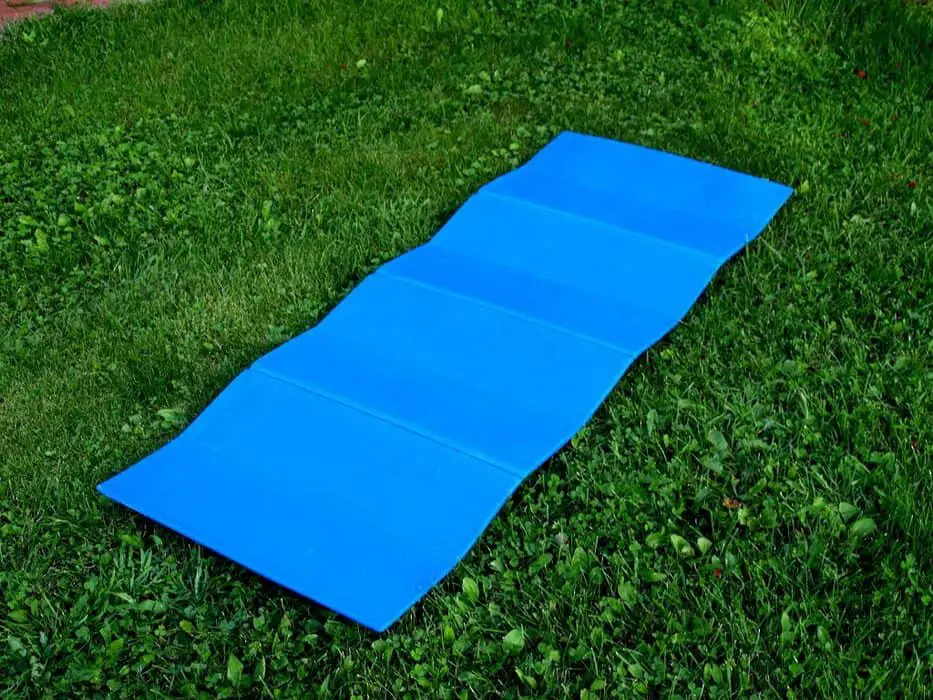On my first long hike, which was the West Highland way in Scotland, I didn’t know much about sleeping pads. The only thing I knew was that I needed one. When I got there, I decided to buy the air type, because I was told this would be the most comfortable. Frankly, it was. During nights I could barely feel the ground underneath. Nevertheless, that pad was heavy on my back, so it brought me to the obvious question – Foam vs. Air Sleeping Pads – What Really Matters?

Foam vs. air sleeping pad is a known issue all future trekkers would have to deal at some point. In this article, I will describe the pros and cons each type features, hoping that it would help you make a wise decision. The main factors should be taken into account are weight, thermal insulation, comfort and how easy it is to be packed.
Foam Sleeping Pads

PROS:
- Easy to pack & unpack
- Thermal insulation
- Lightweight
CONS:
- Not as comfortable
- Bulky
- Bad for side sleepers
Easy to pack & unpack
If your trekking trails are short, or you tend to make a lot of resting stops along the road – you would probably favor the foam sleeping bags.
There is not much to do, you unfold it and place it on the ground.
That makes it suitable for more activities rather than just sleeping.
If you are looking for a coffee break, or just for a few minutes to admire the surroundings, a foam pad would do the trick.
That’s in opposed to air sleeping pads, which usually require more effort to set up.
Thermal insulation
As mentioned above, foam pads feature little, microscopic air pockets. This air provides a thermal barrier between your body and the ground.
If you are sleeping in a cold environment, especially in winter/autumn months, that can make a huge difference.
Now, common sense would say that air pads feature even more air, so how come they are weak with insulation?
Well, some air pads would insulate better than foam, but for that to happen the foam pad has to be thin.
The air pads do feature air inside, yet it is not trapped. Instead of staying at the place, there is a continuous flow inside the pad – this way the cold air which comes from the ground would mix with hot air from your body.
Lightweight
Let’s admit it, on camping or hiking; your backpack is probably heavy enough.
One of the most noticeable differences between foam and air sleeping pads is weight. Foam pad would weigh around 0.5-0.75 pounds, turning it ideal for long hikes.
The main reason for this lightweight is due to the foam’s air pockets.

Think about it – a significant part of the foam is just air. Its job is to maintain thermal insulation and provide a comfortable surface to sleep on.
In opposed to this, air sleeping pads are usually made with plastic, which is way heavier.
Not as comfortable
One of the prominent disadvantages of a foam pad is its thin feature.
With rocks beneath your tent/sleeping bag, it is essential the pad features some width.
Air sleeping bags usually provide a larger space between your body and the ground when being fully inflated.
Nevertheless, that issue can be overcome.
There are several thick foam sleeping pads, like the Outdoorsman Lab Ultralight or the Klymit Static V Lightweight, but these would be a bit more expensive than the simple ones.
Bulky
With an occupied backpack (sometimes to its fullness), extra room in a scarce ingredient.
I had a bad experience with this because of poor backpack choice; however, that problem could happen to anyone.
Even though its thinness, a foam sleeping pad is not as compact as an air one.
It usually can be folded several times, or be rolled up, but that is not enough for it to be packed inside your backpack.
If you have outer straps that could attack the pad quickly, that wouldn’t be a significant problem.
If you don’t – you might consider getting an air pad, which can be rolled very compactly inside your pack.
Bad for side sleepers
That is a big problem which is sometimes not recognized in time, only at first night of camping.
Then, you have to endure terrible long nights until your camping is over. For its being thin, a foam sleeping pad can be hard for side sleepers.

Our shoulders and hips are the two main joints which suffer the most significant amount of pressure during nighttime.
When they encounter the ground beneath, it can be impossible to fall asleep. Then you have to try sleeping on your back, which can be very frustrating for someone who is not used to.
If you are a side sleeper – I think an air pad would be a better choice.
If you still wish to stick with a foam pad – try getting a thick one, or even try it out at home or the store before your journey.
Air Sleeping Pads

PROS:
- Extremely comfortable
- Pack down really small
CONS:
- Takes time to inflate
- Heavy
- Can get a leak
- Mold build inside
- Noise while moving around
- Bad for dog paws
- Expensive
Extremely comfortable
When it comes to comfort, air sleeping pads usually win the jackpot.
That is for them being extremely thick when fully inflated. In contrast to foam pads, they are usually comfortable for side sleepers as well.
My favorite one in that category would be the IFORREST Self-Inflating which also features a built-in pillow.
They would be an excellent choice for rough terrain with tiny bumps; however, they won’t perform as good on the cold ground.
Along with their thickness, they also feature an internal air circulation which can be problematic in cold condition, just as mentioned above.
Pack down small
Whether your backpack features proper outer straps or not, you would probably do just fine with an inflatable sleeping pad.
When empty, these pads can roll very tightly and can easily be stored inside your backpack.
This would be extremely comfortable and ideal for long hikes, in which gear hanging from the outside can burden your lower back.
They usually do weigh more, yet, weight distribution is different for gear located inside your pack. These would burden areas around your hips, rather than your spine.
Takes time to inflate
After a long hiking day, you finally got to your destination.
All you want to do now is to set up your tent, read a book and go to sleep. However, you have to inflate your sleeping pad first.

This could not sound like a big deal, but when you have to do it repeatedly every night – it’s exhausting.
Not just that, you also have to deflate your pad in the morning, before taking off.
Believe it or not, this might be more time to consume than inflating it.
Time and effort are two hugely essential components concerning camping or hiking, and choosing an inflated pad can, unfortunately, consume them.
Heavy
With your backpack being heavy enough, each pound could be spared counts. Air sleeping pads can weigh double than foam ones, mainly due to their plastic cover.
If you are hiking short distances – heavy gear might not be a big issue, and you would probably do just fine with the inflatable ones.
Although, if you are hiking 6-8 miles each day, consider using a foam sleeping pad.
Can get a leak
In opposed to foam pads, air ones can get leaked.
A broken branch or a sharp stone could easily puncture your pad while sleeping. A more common reason, which is not always recognized, would be during deflation.
On mornings you are usually in a rush – you have your schedule, and you don’t want to waste any time.
At this point, you might pay less attention to the ground which you are working on.
Deflating requires you to put some pressure so air would flow out, nevertheless that pressure can perforate your pad on an inappropriate surface.

Once you have a leak and cannot fix it – the pad is done and would be just useless to the rest of your trip.
Mold build inside
Air pads usually require you to inflate them with your mouth.
That, in turn, would bring breathing humidity to accumulate inside. That damp has just nowhere to evaporate.
The humidity inside will result in mold overtime, which in turn would be unhealthy and dangerous.

Once its there, it is almost impossible to get rid of it. If you have a different way for inflation, which includes dry air, that would be fine.
However, if you are planning on self-inflation, you should consider mold occurrence seriously.
At this topic, you might find my article about why sleeping bags get damped useful as well.
Noise while moving around
We all know that annoying noise when rubbing a balloon. Well, air pads won’t be as much as terrible, although they do make noise when flipping sides.
If you are camping with a partner or family, you should highly consider that issue.
In opposed to foam pads, air ones are made with sort of a plastic cover and a boisterous one.
That wouldn’t be such a big deal for you, but that might be a different story for your partners.
Bad for dog paws
That might not be relevant for most of you, but if you are planning on camping with a dog – air sleeping pads are a big no-no.

That is pretty obvious the dog paws can puncture your pad, but it is also straightforward not to take into account.
If you are camping with dogs, or with any pets in general, highly consider using a foam pad instead.
Expensive
That varies between different pads, yet, air sleeping ones are in general more expensive than foams.
I am not saying there aren’t any good deals out there, however, if the budget is one of your primary consideration, check some foam pads before making a purchase.
What to do With a Punctured Sleeping Pad?
A punctured sleeping pad has not done its job yet – there are ways to overcome this.
One of them would be patching it up – all you have to do it get yourself a patch and an adhesive.
First, you have to clean up the whole area thoroughly, removing any trace of dirt.
When it dries out, apply the adhesive (such as a Seam Grip) and patch it up (with Tenacious Tape for instance). A full guide for this process can be found here.
Is it Possible to benefit from both worlds?
That is possible. I haven’t tried this one, but some comments over the internet highly favor combining both.
One exciting way that I’ve read was placing the foam pad over the air one.
This way you still enjoy a proper width, thermal insulation and won’t be bothered from loud noise when changing posture.
Does an Air Sleeping Pad Have to be Mouth Inflated?
Not always, some air sleeping pads are self-inflated, like the TNH Outdoors Self Inflating Sleeping Pad.
They feature a special air valve that all you have to do is open, and it would fill automatically.
When you are done using the pad, open the valve and squeeze the air out of it. One good advantage for this method is that it doesn’t haste mold occurrence.
Moreover, that feature will save you a lot of time and effort if you wish to make frequent breaks during your hike.
Conclusions
Frankly, there is no direct answer to that question. The verdict between these two would eventually be made based on personal preference.
Nevertheless, there are some key factors you should be aware of upfront. If you tend to lightweight gear with more thermal insulation – may be the foam would be better for you.
In contrary, if you are looking for extra comfort and small packing, perhaps the air sleeping pad would be a better choice.
Nevertheless, remember that the foam tends to be bulkier and might be sorry for side sleepers, while the air one might be heavier, would accumulate mold and perhaps would leak at some point (yes, that is still manageable).
I hope my article helped you form a decision, let me know about your hesitations by leaving a comment below!

